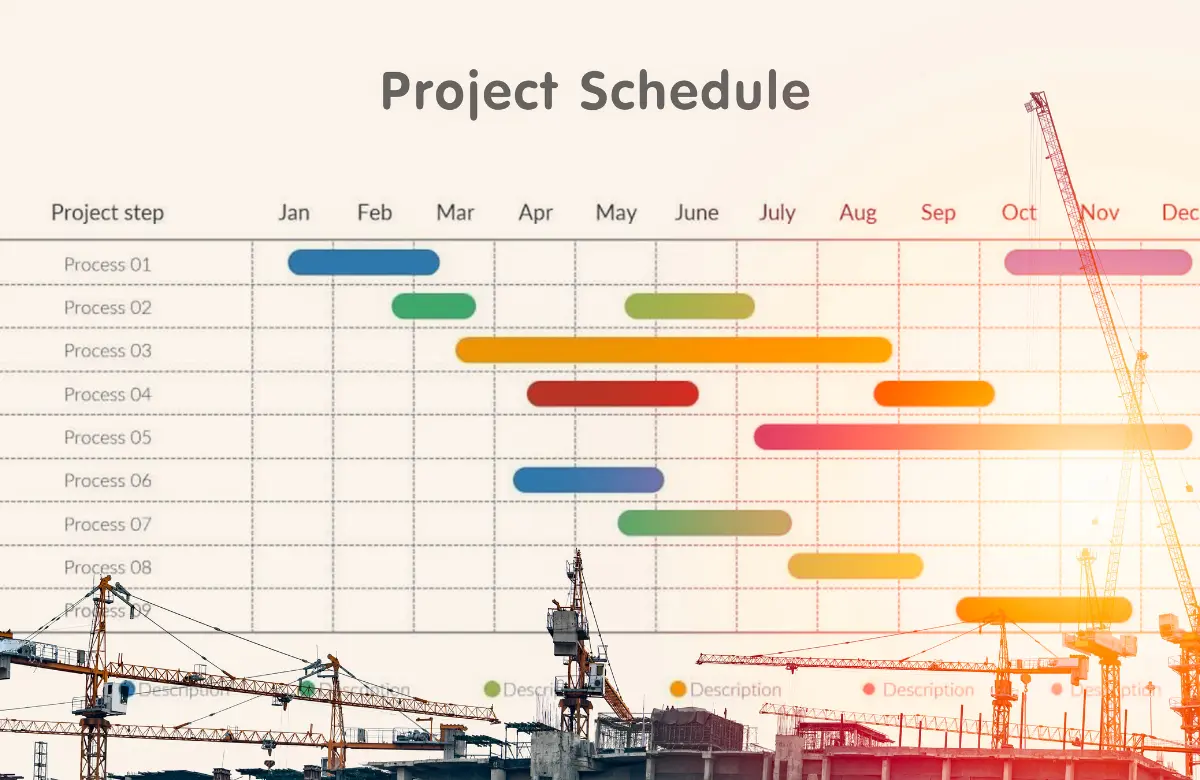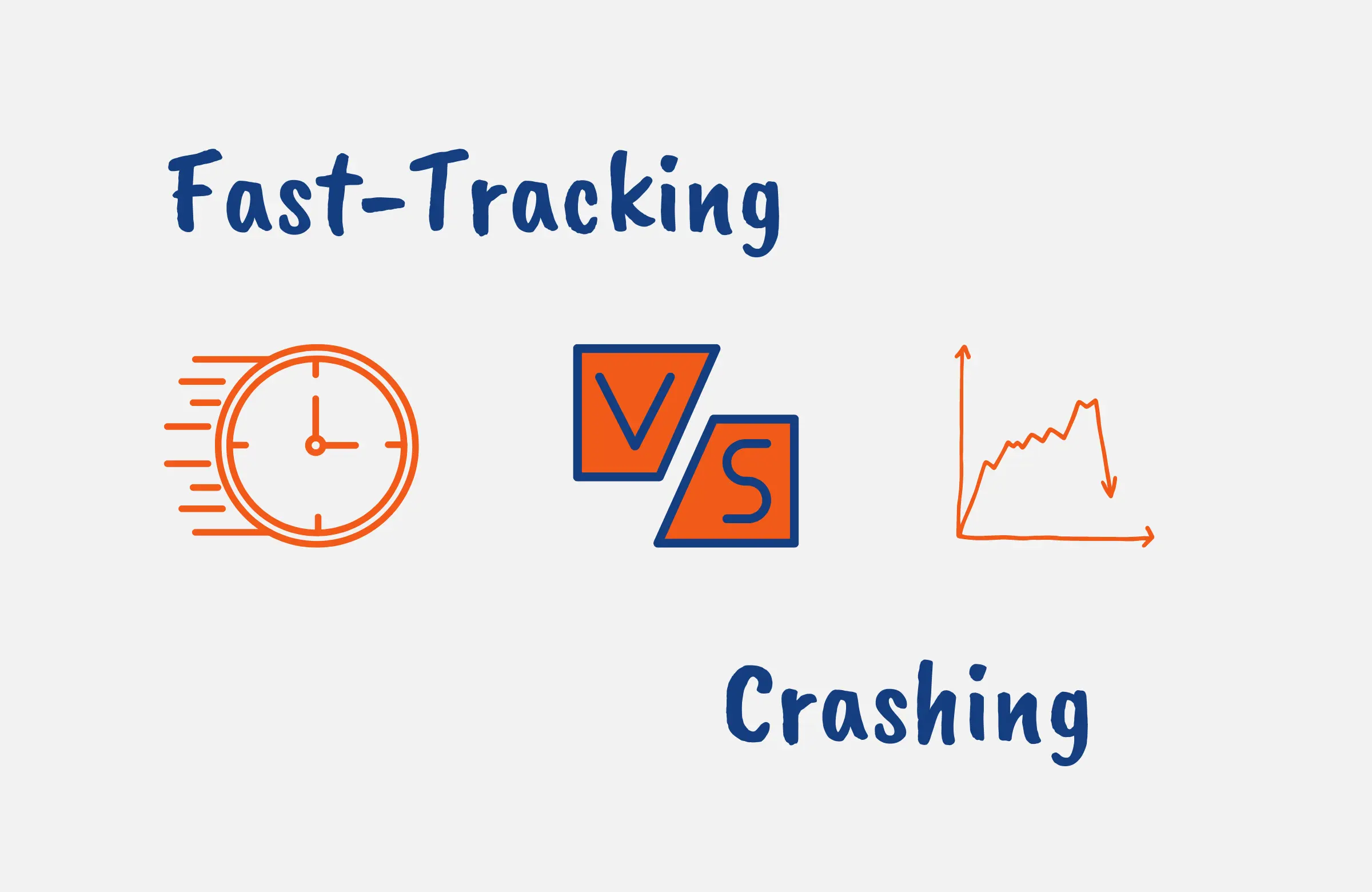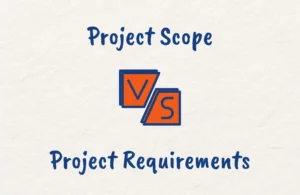Delays are a very common occurrence when managing projects. A study shows that less than 1% of projects are completed on time and within schedule.
When experiencing delays in your project, there are techniques such as fast tracking and crashing that you can leverage for project schedule compression without compromising the project scope to get back on track.
In this post, we’ll compare fast tracking vs crashing in project management over their differences, pros and cons, how and when to use either of them for schedule compression, as well as examples of both techniques.
Also, if you are preparing for the PMP certification exam, you need to have a good understanding of these techniques when facing questions from the project schedule management knowledge area, and this article provides the required knowledge.
What is Schedule Compression in Project Management?
Schedule compression refers to shortening the project timeline without reducing the overall project scope.
Common scenarios where you would compress the schedule include when:
- The project delays or is falling behind schedule
- Sudden priority shifts require an expedited timeline
- External factors are shortening the available timeframe
The two main schedule compression techniques are:
- Fast tracking
- Crashing

Difference Between Fast Tracking and Crashing in Project Management
Fast tracking and crashing are both techniques that aim to compress the project schedule but with different approaches and trade-offs to consider.
Fast tracking involves performing project tasks in parallel that would typically be done sequentially which allows you to shorten the project schedule.
Crashing, on the other hand, involves adding more resources like people, equipment or working overtime to project tasks to shorten their duration while maintaining the original sequence of tasks.

What is Fast Tracking in Project Management?
As earlier iterated, fast tracking involves performing project activities in parallel that were originally planned to be sequential by overlapping tasks that aren’t dependent on each other to compress the schedule.
For example, you may start preliminary testing while still finalizing module development. Or begin foundational site work while architectural plans are still being completed.
Fast tracking reduces project duration by allowing independent paths of work to progress simultaneously thus eliminating or reducing dependencies between tasks.

What is Crashing in Project Management?
Crashing is a technique that aims to shorten project activity durations by adding resources such as additional budget, staff, equipment, etc. at critical path tasks to complete them faster.
For example, paying team members overtime to finish faster, securing additional equipment to enable parallel work, or outsourcing activities to expand capacity.
Crashing reduces the overall project timeline by allocating extra inputs to compress key work package durations, and expedites activities by increasing resource assignments.
Example of Fast Tracking in Project Management
Let’s look at an example of fast tracking to shorten the schedule using a kitchen renovation project scenario.
The original plan was to fully complete cabinet design and selection before starting demolition work. However, the client now needs to finish 3 weeks earlier to host a big event.
As the project manager, you determine the cabinet design and demolition are independent activities.
Therefore, you decide to fast track them by beginning the demolition while finalizing cabinet specifications.
You ensure the demolition team knows which areas will have new cabinets installed. They focus initial work on other areas while the cabinet designer wraps up her piece.
By overlapping these tasks, you’ll expedite the overall renovation timeline by 2 weeks without having to increase the budget or resources.
The key is understanding task dependencies and recognizing where parallel work can occur rather than forcing purely sequential steps.
Example of Crashing in Project Management
To demonstrate how crashing works in project management, let’s look at a software development project scenario where the project is trending 2 weeks behind schedule.
After reviewing the critical path, you identify the coding and testing of a key feature as the main bottleneck.
To crash this activity, you bring on 2 additional developers to help expedite the coding and also authorize overtime for the QA team to bolster testing bandwidth once development finishes.
By adding these resources, you’re able to reduce the initial 4-week timeline down to 2.5 weeks, saving 1.5 weeks. The crashing costs include:
- 20 hours/week overtime for 2 QA testers for 1.5 weeks
- 2 additional contract developers for 2.5 weeks
In this case, the incremental spending was justified to crash the schedule based on the project delays.
Crashing requires a budget for extra resources to buy back time against aggressive timelines. Note that you don’t need to crash the entire project, just target activities on the critical path.

Fast Tracking vs Crashing in Project Management: Comparison
Having defined fast tracking and crashing, let’s compare their features to highlight key differences:
1. Approach
Fast tracking focuses on scheduling activities in parallel that were originally sequential in the project plan.
Crashing on the other hand centers on adding resources to shorten durations for critical path activities.
2. Dependencies
Fast tracking aims to overlap tasks with minimal dependencies while crashing works even when dependencies exist between activities by throwing resources at downstream handoffs.
3. Costs
While fast tracking does not significantly increase costs if leveraging existing project resources, crashing often increases the budget to pay for additional resources like overtime.
4. Risks
Fast tracking can increase risks due to untested overlaps between activities. However, crashing has minimal impact on risks, provided the new resources are properly managed.
5. Duration Focus
Fast tracking reduces overall project duration by executing parallel paths simultaneously. Crashing compresses the critical path by expediting specific high-impact activities.
6. Technique Ordering
Use fast tracking first to gain quick efficiencies through work rearrangement. Implement crashing secondarily to further compress the schedule after sequencing changes.
Pros and Cons of Fast Tracking Your Project Schedule
When using the fast tracking technique to compress your project schedule, it is important to evaluate the merits of fast tracking specific activities or entire projects.
Advantages of Fast Tracking in Project Management
Fast tracking offers several benefits including:
- Reduces project duration without increasing budget or resources. You simply progress parallel activities simultaneously.
- Enables earlier project completion which can allow faster time to market, improved customer satisfaction, and other schedule-related benefits.
- Leverages existing project resources and plans more efficiently by eliminating unnecessary sequential dependencies.
- Provides more flexibility in resource allocation since independent work streams operate concurrently.
- Focuses on expediting project critical path through targeted overlapping of driving activities.
- Can increase project sponsor satisfaction by meeting urgent schedule compression needs.
- Low complexity to implement by making sequencing adjustments in scheduling.
Disadvantages of Fast Tracking in Project Management
However, some downsides to fast tracking exist:
- Increased risk of quality issues or rework from untested overlapping of work as activities may negatively impact each other.
- More potential for miscommunication and coordination challenges between parallel teams.
- Resource bottlenecks can develop if multiple activities require the same personnel or assets concurrently.
- May require additional project management oversight to juggle and deconflict parallel work streams.
- Fast tracking all activities without regard to dependencies leads to project delays.
Pros and Cons of Crashing Your Project Schedule
Similarly, the choice to use crashing for project schedule compression has its merits and drawbacks which you need to consider.
Advantages of Crashing in Project Management
Key benefits of crashing in project management include:
- Compresses project schedule by expediting critical path activities through additional resource allocation.
- Allows you to meet accelerated deadlines from project sponsors or clients.
- Helps mitigate downstream risks of prolonged schedule delays.
- Brings specialized expertise or bandwidth to speed up complex work packages.
- Provides schedule buffer on non-critical paths by pulling in the duration of driving activities.
- Enables late projects to get back on track through targeted schedule compression.
- Allows you to optimize work based on which activities offer the best cost/duration tradeoff when crashed.
- Can improve customer satisfaction and priority over competing projects.
Disadvantages of Crashing in Project Management
The potential downsides of crashing include:
- Increases project budget to pay for additional resources like overtime, equipment rentals, 3rd party services, etc.
- Higher resource utilization can increase risks of fatigue, turnover, and reduced quality.
- Partially complete work may sit idle waiting for upstream crashed activities to finish.
- Crashing all activities without assessing the critical path wastes the budget for minimal schedule gain.
- Vendors may charge premium rates for expedited equipment, materials, or temporary contractors.
- New resources may take time to integrate with the existing project team.

When to use Fast Tracking vs Crashing in Project Management
Now when faced with a situation where your project falls behind schedule, which of the schedule compression techniques do you use?
You need to first of all evaluate the unique situation of your project to determine if fast tracking, crashing, or both together are appropriate.
Then, assess the costs versus benefits of each technique and secure buy-in from sponsors on the path forward. These tips detail the optimal choice for different situations.
When to use Fast Tracking in Project Management
Consider fast tracking when:
- You need to compress the schedule without increasing the budget.
- Independent activities exist that can be executed in parallel.
- Access to required resources is not constrained.
- The project plan has unnecessary dependencies that create delays.
- Mitigating quality risks from concurrent work is feasible.
- Activities do not strongly impact each other when they overlap.
- Project sponsors request earlier delivery without added costs.
When to use Crashing in Project Management
Crashing is better suited when:
- Project delays require schedule compression despite higher budgets.
- The critical path has clearly identifiable resource constraints.
- Specific long-lead items demand added resources to expedite.
- Fast tracking has been maximized and more compression is still needed.
- Achieving the desired time savings requires supplemental staff or resources.
- Management fully supports increased expenditure to achieve schedule goals.
- Time savings justify additional resourcing from a business case standpoint.

How to use Fast Tracking in Project Management
Follow these steps to effectively fast track your project:
1. Identify the Critical Path
Focus on expediting activities that fall on the current critical path as overlapping non-critical activities won’t impact the project end date.
2. Map All Dependencies
Understand predecessor and successor relationships between tasks. Avoid fast tracking activities with rigid “finish-to-start” dependencies.
3. Analyze Tasks for Overlapping
Assess which activities can be performed concurrently based on resource needs, deliverables, operational impacts, and risk tolerance.
4. Validate Resource Availability
Ensure you have sufficient resource capacity to execute parallel work streams without causing bottlenecks.
5. Update Project Plan
Modify the project schedule to reflect fast tracked activities by adjusting start/finish dates and dependencies.
6. Enhance Communication
Keep teams informed on changes to minimize confusion from concurrent activity execution.
7. Control Risk
Monitor for quality issues, rework, or delays from unplanned overlaps and mitigate emerging risks proactively.
8. Recalibrate Fast Tracking
If the critical path changes later, then re-assess parallelization opportunities on the new long pole path.

How to use Crashing in Project Management
To successfully crash your schedule, then follow these key steps:
1. Identify the Critical Path
Identify the critical path of the project and then focus on crashing activities that are on it and currently dictate the project timeline.
2. Estimate Crashing Costs
Analyze options like overtime, additional headcount, expedited shipments, 3rd party contractors, etc., and associated costs to get an estimate of what it will cost to crash the project schedule.
3. Assess Time Savings
Evaluate the estimated duration reduction expected from each crashing option to focus on high-value impact activities.
4. Select Crashing Targets
Determine which critical path items to crash based on cost-benefit analysis and management directives.
5. Secure Added Resources
Obtain budget approval and lock down supplemental staff, equipment, facilities, or services needed to enable crashing.
6. Update Project Plan
Modify the schedule by reducing crashed activity durations and recalculate the schedule.
7. Manage New Resources
Onboard new team members and assets quickly. Monitor their utilization and performance.
8. Track Progress
Watch for emerging resource bottlenecks or delays from suboptimal crashing execution, and refine your approach as needed.
Conclusion
Fast tracking and crashing are two powerful techniques you can deplore for schedule compression when facing delays in your project.
Fast tracking shakes out inefficiencies by overlapping independent work while crashing throws resources at the critical path to expedite progress.
Before deploying either technique, carefully weigh the associated budget impact and risk implications.
With mastery over when and how to leverage these approaches, you can consistently deliver projects on time through targeted schedule compression.
FAQs
Which is Better Crashing or Fast Tracking?
Neither crashing nor fast tracking is inherently better; it depends on the project situation.
Crashing can speed up the project but increases cost, and fast tracking may introduce risk by overlapping activities. The best choice depends on the specific constraints, risks, and needs of the project.
When is it not Appropriate to Use Fast Tracking in Project Management?
Fast tracking is not appropriate when tasks heavily depend on each other’s outcomes, when there’s a high risk of errors due to rushing, or when team members lack the necessary skills or resources to handle concurrent tasks. It’s also unsuitable when quality cannot be compromised.
Why Do We Apply Schedule Compression on Critical Path Activities?
We apply schedule compression on critical path activities because they directly impact the project’s total duration.
By shortening the time of these activities through techniques like fast tracking or crashing, we can reduce the overall project timeline, thereby meeting deadlines or accelerating delivery.
What are the 3 Schedule Compression Techniques?
The 3 primary schedule compression techniques are crashing, fast tracking, and resource reallocation.
Crashing involves shortening durations by adding resources to critical path activities, fast tracking overlapping sequential activities by progressing independent work streams in parallel, and resource reallocation involves improving resource allocation to maximize productivity.
How does Agile Address Schedule Compression?
Agile addresses schedule compression by promoting incremental development and continuous delivery.
By delivering work in small, manageable chunks (sprints), Agile allows for flexibility and adjustment in response to changes, helping teams maintain a sustainable pace and avoid the need for drastic schedule compression.





